
The Corridor of Doors
A comfortable, unlived-in look
After passing the restless guest in the conservatory, visitors to the Haunted Mansion will find themselves traveling down a long corridor. Eerie wallpaper seems to watch you as you make your way past dreary family portraits and a sampler which proclaims "TOMB SWEET TOMB." As you pass through the long corridor with many doors on either side, you notice that the handles are twisting and turning... from within.
Some of the doors are being pounded on, from the inside, and one even seems to be, well... breathing! Eerie sounds of moaning ghouls pounding, knocking, and begging for release fill the air as you continue onward, and beastly hands try to force their way out from inside one of the rooms, even pushing out the top corner of one door.
A Haunting premise
This haunting "Corridor of Doors" was in part inspired by Robert Wise's 1963 film The Haunting, (which in turn is based on Shirley Jackson's book The Haunting of Hill House) in which a very similar "breathing" door terrorizes guests, and in which menacing, pounding sounds intimidate the visitors to Hill House. The overall chilling atmosphere and scene design is largely a result of the conceptual work of WED's Claude Coats, who is responsible for many of the Mansion's darker tones.
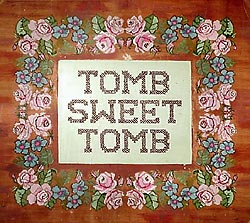
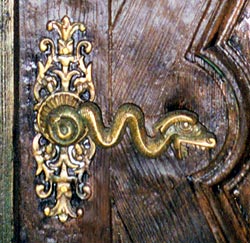
Pimp my corridor
As is typical of this attraction, intricate details abound, including bronze doorknockers which look like miniature spiked maces and door handles which are cast in the image of dragons (see detail at left.) Small motors on the back of the doors keep the handles clanking and the knockers knocking. The practical sounds of clanging hardware blend with the recorded soundtrack of supernatural ghoulies trying to escape into the Corridor to crreate a unique cacophony, which may inspire claustrophobia and dread.
Wooden you like to know
The "woodwork" of the Haunted Mansion is of special note in the Corridor of Doors, since some of the "wood" actually appears to be taking on a life of its own, as doors seem to inhale and exhale by bulging out toward the Doom Buggies. Guests may note the intricacy of the carved wood as they move throughout the Corridor scene (and throughout the Mansion as a whole, actually, as there are numerous examples of the carved architectural design throughout the attraction).
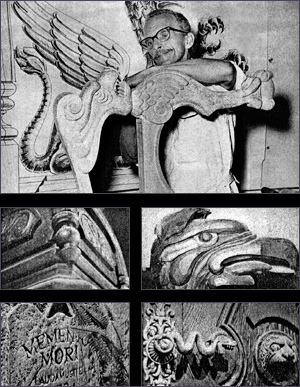 These
details are largely the work of a Cuban scultptor named Ciro Rolando Santana
y Arrite (pictured at right, with some of his work from the Haunted Mansion),
who had arrived in the United States only weeks before he heard that WED
was looking for a new sculptor. Santana had already been a successful sculptor,
having been exhibited throughout Central America and Spain for 20 years
prior to coming to the States. He also had been formally trained in Cuba
at Havana's St. Alexander's National School of Fine Arts and the Havana
Center for Fine Arts. With such an impressive resume, Santana was promptly
hired to join WED, and his first task was to design and carve wooden furniture
and ornamentation for the Haunted Mansion. His work can also be seen in
the Graveyard, as he was responsible for carving many of the orginal tombstones.
These
details are largely the work of a Cuban scultptor named Ciro Rolando Santana
y Arrite (pictured at right, with some of his work from the Haunted Mansion),
who had arrived in the United States only weeks before he heard that WED
was looking for a new sculptor. Santana had already been a successful sculptor,
having been exhibited throughout Central America and Spain for 20 years
prior to coming to the States. He also had been formally trained in Cuba
at Havana's St. Alexander's National School of Fine Arts and the Havana
Center for Fine Arts. With such an impressive resume, Santana was promptly
hired to join WED, and his first task was to design and carve wooden furniture
and ornamentation for the Haunted Mansion. His work can also be seen in
the Graveyard, as he was responsible for carving many of the orginal tombstones.
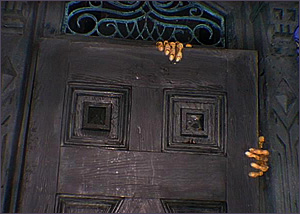 At
left, you can see more examples of Santana's sculptural work, as well as one
of the Corridor's gags in which a resident of the Mansion seems to be trying
to escape into the Corridor as the Doom Buggies crawl past.
At
left, you can see more examples of Santana's sculptural work, as well as one
of the Corridor's gags in which a resident of the Mansion seems to be trying
to escape into the Corridor as the Doom Buggies crawl past.
A high-flying "hallway"
Previous Haunted Mansion cast member Shawn Potts reports on the physical structure of the Corridor of Doors scene: "It's interesting to note that the Haunted Mansion show building interior is constructed very much like a Hollywood sound stage, which is not surprising, considering the nature of the attraction. This means that it is essentially a large building with a continuous set that winds its way through. When you're getting into your Doom Buggy, you're essentially on the second floor. The actual floor of the building is some 15 feet below. Also, the second and third floors only exist in areas where the vehicles travel. So when you're in the Corridor of Doors, you're actually in a corridor-shaped tunnel, suspended about 30 feet in the air by complex wooden supports. There is one real door. It's an emergency exit that leads to a rickety wooden staircase."

I only have eyes for you
The Corridor of Doors also is the home of the famous purple "Demon Eye Wallpaper," which papers the walls around the doors and underneath the framed portraits. The design for this purple and black wallpaper was illustrated by WED Imagineer Rolly Crump. The idea behind the wallpaper design (as well as many of the architectural elements sculpted by Santana) is to add to the viewer's sensation of being watched by the Mansion itself. The "Demon Eye" backdrop serves another function, as well - if smart aleck guests ever stop a Cast Member and demand that they explain how the attraction could hold "999 Happy Haunts," the cast member can always remind the guest that they need to count all the demons trapped in the wallpaper as well!


All in the family: the Corridor portraits
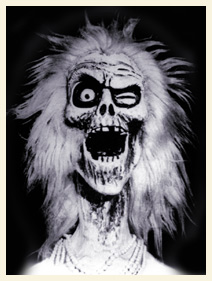
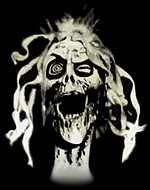 The
"family portraits" in the Corridor of Doors are another example
of the Haunted Mansion's wonderful detail. Most of the images are actual
photographs of costumed prop heads that were actually created from the same
molds as some of the animatronic characters found throughout the attraction.
Hung and displayed throughout the corridor in fancy gilded wooden frames,
the grotesque characters add a whisical sense of mystery to the ride, as
well as some foreshadowing for the creatures waiting ahead.
The
"family portraits" in the Corridor of Doors are another example
of the Haunted Mansion's wonderful detail. Most of the images are actual
photographs of costumed prop heads that were actually created from the same
molds as some of the animatronic characters found throughout the attraction.
Hung and displayed throughout the corridor in fancy gilded wooden frames,
the grotesque characters add a whisical sense of mystery to the ride, as
well as some foreshadowing for the creatures waiting ahead.
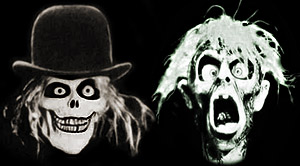 Many
of the portraits, such as the "matriarch" of the family pictured
above at right, are narrow depth-of-field photos, simulating turn-of-the-century
daguerrotypes. (Click on the photo of the "matriarch" to download
a high-resolution copy to hang in your own haunted family gallery!)
Many
of the portraits, such as the "matriarch" of the family pictured
above at right, are narrow depth-of-field photos, simulating turn-of-the-century
daguerrotypes. (Click on the photo of the "matriarch" to download
a high-resolution copy to hang in your own haunted family gallery!)
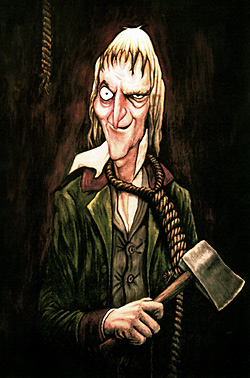
Just hangin' around
Two of the images of family members that have been displayed in the Disneyland Corridor of Portraits are not photographs at all: One is a small portrait that was sketched by an anonymous Cast Member and hung in the Mansion for a number of years before being removed in a ride rehab (see detail above, top center). The other is a painting of a man, in a noose, holding a bloody hatchet (in another atypical example of Disney grue). The hanged-man image comes from a concept by Marc Davis (pictured, left) which is still used in the Walt Disney World Haunted Mansion, with the original Disneyland version (painted by Joe Denton) pictured below, right.
Many Haunted Mansion fans speculate that the image of the "Hanged Man" actually represents the "Ghost Host," whom we saw hanging from a noose in the Stretching Gallery. While this is not directly spelled out by the Mansion's designers, this is certainly an interesting bit of conjecture.
Trivia time: a bloody fool
 Note
that neither of these versions has blood on the axe; the bloody hatchet
that has been seen in the Disneyland Corridor of Doors was added to a recreated
version of the painting. The blood was added by the rehab artist as a personal
twist, though it didn't quite fit the story being told in the image. The
severed noose gives a clear meaning for the use of the ominous hatchet,
though the addition of blood (and therefore violence) was never necessarily
intended to be made so plain in Davis' original concept sketch. Denton's
image did add a neck wound and dabs of blood on the subject's clothing,
possibly from the suject's own injury. In any case, the image provides a
sinister, yet comical, character which adds yet another layer to the mythology
surrounding the Mansion.
Note
that neither of these versions has blood on the axe; the bloody hatchet
that has been seen in the Disneyland Corridor of Doors was added to a recreated
version of the painting. The blood was added by the rehab artist as a personal
twist, though it didn't quite fit the story being told in the image. The
severed noose gives a clear meaning for the use of the ominous hatchet,
though the addition of blood (and therefore violence) was never necessarily
intended to be made so plain in Davis' original concept sketch. Denton's
image did add a neck wound and dabs of blood on the subject's clothing,
possibly from the suject's own injury. In any case, the image provides a
sinister, yet comical, character which adds yet another layer to the mythology
surrounding the Mansion.
The Corridor of Doors provides Haunted Mansion fans with some of the most recognizable artwork developed for the ride. It provides comic relief, while maintaining a ghastly charm... a thin line that the Haunted Mansion walks successfully throughout the entire show.
Multipurpose props
Pictured below is the actual prop head that was used in some of the photos taken for the Corridor of Doors (showing glue remnants from where it had hair attached and was used as a "pop-up" ghost in the graveyard for a number of years). Many of the Haunted Mansion "face" props are used in different settings with different costumes. In fact, one of the ballroom ghosts shares an animatronic face with one of the pirates from Disney's Pirates of the Caribbean attraction.
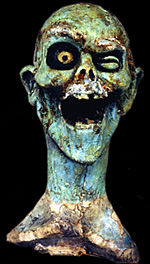 The
"sloping-eyebrows/one-eye-popping" visage is used a number of
times throughout the Haunted Mansion. The skeletal "Hitchhiking Ghost"
and the original "Hatbox Ghost" both had similar faces, but with
their jaws clamped shut in a skull-like grimace.
The
"sloping-eyebrows/one-eye-popping" visage is used a number of
times throughout the Haunted Mansion. The skeletal "Hitchhiking Ghost"
and the original "Hatbox Ghost" both had similar faces, but with
their jaws clamped shut in a skull-like grimace.
For whom the bell tolls
At the end of the Corridor of Doors, before exiting out around a corner into the mysteries that await, the Doom Buggies pass an odd grandfather clock, with a glowing dial that marks the hour of "13," and a demonic tail for a pendulum. As the minute hand swings wildly, the shadow of a huge clawed hand swoops down over the face, as if an enormous beast is sweeping down over your carriage as you narrowly scoot past. The scene also sets the stage for the otherworldly seance that is about to unfold.
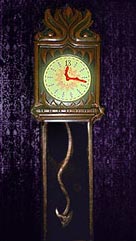 This
creepy clock is reproduced in each of the Haunted Mansions (and in Phantom
Manor in Paris as well), as is the projected claw grasping for victims,
which is a simple motorized rotating silhouette and spotlight.
This
creepy clock is reproduced in each of the Haunted Mansions (and in Phantom
Manor in Paris as well), as is the projected claw grasping for victims,
which is a simple motorized rotating silhouette and spotlight.
As with many of the architectural details in the Haunted Mansion, the 13-hour grandfather clock has been given menacing features to make it come alive and appear to be watching the guests that pass by. The top of the clock resembles a horned head, while the fanged maw surrounds the face of the clock.



